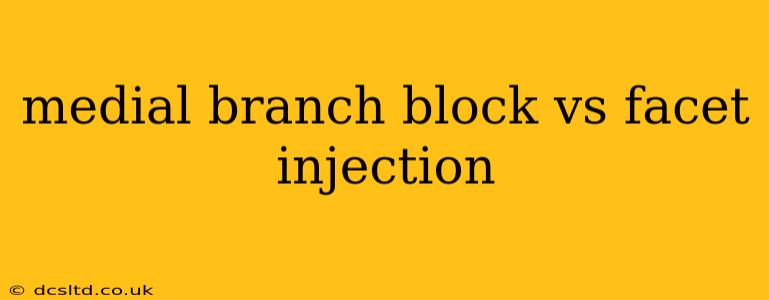Chronic lower back pain can be debilitating, and finding the right treatment is crucial. Two common procedures used to diagnose and treat this pain are medial branch blocks and facet injections. While both target the facet joints, a source of significant back pain for many, they differ in their approach, purpose, and overall effectiveness. This article will delve into the key differences between medial branch blocks and facet injections, helping you understand which might be suitable for your situation.
What is a Medial Branch Block?
A medial branch block is a diagnostic and therapeutic procedure primarily used to identify the source of lower back pain. It involves injecting a local anesthetic near the medial branch nerves, which supply sensory information to the facet joints. If the pain is significantly reduced after the injection, it suggests the facet joint is the primary pain generator. This confirmation is crucial before considering more invasive treatments. The anesthetic effect is temporary, lasting only a few hours to a few days. If the pain relief is substantial and lasts, a longer-lasting medication may be injected.
What is a Facet Injection?
A facet injection, unlike a medial branch block, is primarily a therapeutic procedure. It aims to provide longer-lasting pain relief by injecting corticosteroids and sometimes a local anesthetic directly into the facet joint. The corticosteroids reduce inflammation within the joint, offering prolonged pain relief that can last for weeks or even months. This procedure doesn't necessarily confirm the facet joint as the pain source, though this is often already suspected or confirmed by other means, including a medial branch block.
What are the Differences Between Medial Branch Blocks and Facet Injections?
The primary differences lie in their purpose and the substances injected:
- Purpose: Medial branch blocks are primarily diagnostic, while facet injections are primarily therapeutic.
- Substances Injected: Medial branch blocks typically use local anesthetics, whereas facet injections use corticosteroids and sometimes local anesthetics.
- Duration of Effect: Medial branch blocks provide temporary pain relief (hours to days), while facet injections offer more prolonged relief (weeks to months).
- Procedure: While both involve injections, the precise location of the injection differs, targeting the medial branch nerve in one and the facet joint itself in the other.
What are the potential side effects?
Both procedures carry the risk of side effects, though generally minor. These can include bleeding at the injection site, infection, nerve damage (rare), and temporary worsening of pain. A qualified medical professional should discuss the risks involved before proceeding with either procedure.
Which procedure is right for me?
The choice between a medial branch block and a facet injection depends on several factors, including:
- Diagnosis: If the source of your pain is uncertain, a medial branch block is often performed first to help pinpoint the culprit.
- Treatment Goals: If your goal is to confirm the facet joint as the pain source, a medial branch block is appropriate. If you are seeking more prolonged pain relief, a facet injection may be a better option.
- Pain Severity: The severity and type of your back pain will also factor into the decision.
- Previous Treatments: Your response to prior treatments will inform the selection of the appropriate procedure.
Are there any alternatives to medial branch blocks and facet injections?
Yes, several alternative treatments exist for lower back pain, including physical therapy, medication (pain relievers, muscle relaxants), and lifestyle modifications. Your doctor can help determine the most suitable approach for your individual needs and medical history.
What should I expect after the procedure?
After either procedure, you might experience some temporary soreness or discomfort at the injection site. You should follow your doctor's post-procedure instructions carefully, which might include rest, ice application, and avoiding strenuous activity.
How long does it take to recover?
Recovery time varies depending on individual responses, but generally, both procedures involve minimal downtime. You might feel some soreness for a few days after the injection, but you should be able to resume your normal activities within a reasonable timeframe. Always follow your doctor's advice concerning recovery and activity levels.
By understanding the distinct differences between medial branch blocks and facet injections, you can discuss your treatment options more effectively with your physician and make an informed decision about the best approach to manage your lower back pain. Remember, this information is for educational purposes only and is not a substitute for professional medical advice. Always consult with a healthcare professional for diagnosis and treatment of any medical condition.
